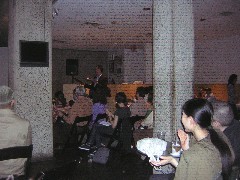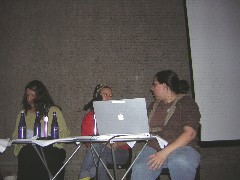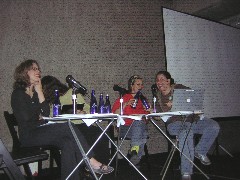
the Whitney staff lights a candle in honor of Zoe Strauss’ birthday (it’s that tiny white spot a little northwest of center
The stars were in triple alignment for another visit to the Whitney, yesterday. For one thing, I was going to be in town for my son’s birthday (really today). For another, it was also artist Zoe Strauss’ birthday (really yesterday). And for still another, Zoe was a participant at one of the biennial-related public programs, a conversation among artists and curators about their work and its place in the biennial. The event was called Fugitives: Objects, Practices, Communities. This artspeak name was a clear, bad sign.
The space, carved out of the downstairs cafeteria, was booked solid. Murray (that’s my husband) did a head count to keep himself awake through the first of the conversations–about 150 people, all dying to hear what the artists had to say. We found some people we knew, including John McInerney of the Greater Philadelphia Cultural Alliance, who cut out early, super-art-fanBrent Burket (Creative Time’s blogger par excellence and his own blogman at Heart as Arena) who stayed, I think, and Zoe’s family–her mom, her aunt, and her partner).
I might have to credit the Whitney, however, for affirming Murray’s belief (that’s my husband if you’re not a regular reader) that art can be a terrible snore. I put the onus right on conversation number one led by Curator Chrissy Iles, with performance artist Momus, and installation artists Jordan Wolfson and Gedi Sibony.
The conversation, which started as a defense of art not focused on object-making (i.e. a defense of this particular Biennial), reached its nadir when Iles went on about how the artists’ work responsed to the ghosts of the past vibrating in the rooms at the Whitney. I tried becoming a ghost myself at that point, transmigrating my soul to some other conversation with my clever and interesting friends. The artists were game enough to try to chat, once Sibony got past mumbling about his own art, but there was no resurrecting this particular conversation.

left to right, panelists Daisy Wright, Carolina Caycedo and Zoe Strauss
The next conversation, which included Strauss, was my reason for being there, and I’m happy to report the four ladies on the panel breathed life and passion back into the room. Murray, who had moved to a drop-out position in the back where he could be near real people, i.e. Zoe’s family, snapped back to attention.
The subject was community, and the four of them–barter-artist Carolina Caycedo, filmmakers Lori Cheatle and Daisy Wright, and street photographer/street-installation artist Strauss–talked about the artwork and its political, social and community purposes.
For starters, Strauss threatened to break out in song–“People” to be specific–and then described mounting her annual PAP show of her color-xeroxed photos on the pilasters under I-95, a monumental task that takes 200 hours, she said. She mentioned several of the people who helped her make that happen. And she showed photos of people enjoying the art. “People, people who need…” That’s me singing as I type.

left to right, panelist Lori Cheatle, Daisy Wright, Carolina Caycedo and Zoe Strauss
Caycedo, using her family van as home base and a red telephone in the lobby at the Whitney, has been taking 10 to 20 calls a day from people willing to drop their guard and enter her barter community. They give her something and she gives them something back, none of the offerings based on monetary value, all of the offerings based on a personal valuation of need. These people become her community. I’m still singing.
And Cheatle and Wright talked about how their movie was a personal escape from their day jobs making films for others. Their film “This Land is Your Land,” screening at the Whitney today at 2 p.m., shows people who have found ways to take back the country by standing up to big business. Cheatle said, “It’s important to look at average people and their getting things done.” The humming is getting louder.
Caycedo said, “You have to work at your everyday life so it’s special…and not a routine.” My Streisand imitation is in full gear.
This was a refreshing change from the cool art crowd. The moderator asked if they were concerned that being in the Biennial was a compromise of the purity of their art.
Cheatle said she felt touched…felt it was an affirmation of the people in the film and their stories.
Strauss said, “Who doesn’t want to be in the Biennial. It’s crazy talk.”
And Caycedo said of the Biennial, “It’s a key that opens a door.” It lets her reach people who she otherwise would not reach.
All said that they did address aesthetic concerns in their work, but it was the personal exchange, the moment of the encounter betwixt equals that kept them going.
Elated by what’s got to be the most important value of all and the reason that I love art when it’s good, I left before the final conversation, which included artists Jutta Koether and Reena Spaulings. But I want to point out that if art is going to succeed in reaching a broader audience, it needs to operate on that level of encounter; it can’t be an obscure conversation all in the artists’ and curators’ heads. Which is not to say it shouldn’t be about ideas. It must be about ideas. But it also must be about connecting with people.
As an afterthought, I realized it was the women who returned the art conversation to real life. But I want to exempt Momus from the black eye on the guys. After all, he is a performer (he is giving misleading tours through the Biennial exhibit), and if he weren’t connecting with people, he’d be cooked.









